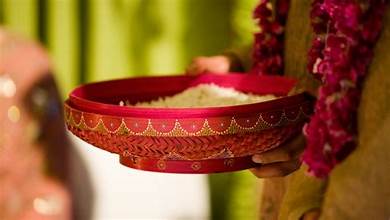In the vibrant and diverse tapestry of Hindu culture, weddings are not just celebrations of love and union but also a deep reservoir of ancient traditions and rituals, each imbued with profound meaning and symbolism. Among these myriad customs, one that stands out for its unique blend of spirituality, tradition, and familial bonds is the practice of the bride scattering grains of rice during her farewell or ‘Vidaai’ ceremony. This ritual, deeply rooted in the ethos of Hindu weddings, carries layers of significance and cultural nuances.
The Essence of the Rice Scattering Ritual
At the heart of a Hindu wedding, amidst the sounds of sacred chants and the colorful setting, is the ritual where the bride, while leaving her parental home, scatters rice or paddy grains. This act, though simple in its execution, is laden with deep spiritual and symbolic significance. The ritual symbolizes the bride’s role as a nurturer and her connection to prosperity and abundance.
The Bride as a Symbol of Prosperity and Fertility
In Hindu culture, the bride is often compared to Goddess Lakshmi, the deity of wealth and prosperity, and Goddess Annapurna, the goddess of food and nourishment. By scattering rice, a staple food symbolizing sustenance and abundance, the bride is seen as bestowing prosperity and fertility upon her parental home. This act is a poignant reminder of the cycle of life and the continuous flow of blessings and abundance.
Cultural Variations and Historical Roots
The practice of scattering rice has its roots in various regional traditions within Hindu culture, with each region adding its unique flavor to the ritual. For instance, in the Nimar region, the tradition holds great significance and has been followed for generations. The rice or paddy grains, touched and scattered by the bride, are collected and preserved by the mother, signifying the retention of prosperity and wealth within the family.
Key Considerations During the Ceremony
Astrological and temporal factors play a significant role in the execution of this ritual. Renowned priests and scholars, like Pandit Shailendra Mukhiya, emphasize the importance of conducting the farewell ceremony at an auspicious time. Avoiding periods like ‘Rahu Kaal’ and paying heed to ‘Choghadiya’, an ancient Hindu Vedic time division system, ensures that the ritual is performed at a time that is most conducive to bringing happiness, prosperity, and good fortune to the bride and her family.
Beyond Rituals: The Broader Implications
This rice scattering ritual is not just a mere custom; it represents a deep connection with the Earth, acknowledgment of life’s cyclical nature, and respect for the role of women as carriers of prosperity and wellbeing. As modern society evolves, these age-old traditions continue to serve as a bridge connecting the past with the present, reminding us of the enduring power of our cultural heritage.
Disclaimer : इस न्यूज़ पोर्टल को बेहतर बनाने में सहायता करें और किसी खबर या अंश मे कोई गलती हो या सूचना / तथ्य में कोई कमी हो अथवा कोई कॉपीराइट आपत्ति हो तो वह jansandeshonline@gmail.com पर सूचित करें। साथ ही साथ पूरी जानकारी तथ्य के साथ दें। जिससे आलेख को सही किया जा सके या हटाया जा सके ।














